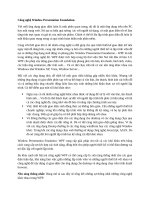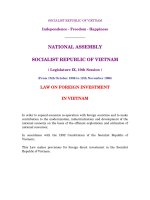Gausss Law presentation
Bạn đang xem bản rút gọn của tài liệu. Xem và tải ngay bản đầy đủ của tài liệu tại đây (1.95 MB, 21 trang )
GAUSS’S
LAW
Electric Flux
The electric flux through a Gaussian surface is a proportional to the
net number of electric field lines passing through that surface.
A Gaussian surface of arbitrary shape immersed in an electric field. The surface
is divided into small squares of area DA. The electric field vectors E and the area
vectors DA for three representative squares, marked 1, 2, and 3, are shown.
The exact definition of the flux of the electric field through a closed surface is
found by allowing the area of the squares shown in Fig 23-5 to become smaller
and smaller, approaching a differential limit dA. The area vectors then approach
a differential limit dA. The sum of Eq 23-5 then becomes an integral:
The symbol has a little circle to indicate that the integral is over a closed surface.
Example: Flux through a closed cylinder, uniform field
Example: Flux through a closed cube, Non - uniform field
Right face: An area vector A is always perpendicular to its surface and always
points away from the interior of a Gaussian surface. Thus, the vector for any
area element dA (small section) on the right face of the cube must point in
the positive direction of the x axis. The most convenient way to express the
vector is in unit-vector notation:
Although x is certainly a variable as we move left to right across the figure, because the right face is perpendicular to the x
axis, every point on the face has the same x coordinate. (The y and z coordinates do not matter in our integral.) Thus, we have
Example: Flux through a closed cube, Non - uniform field
Gauss’s Law
Gauss’ law relates the net flux of an electric field through a closed surface (a
Gaussian surface) to the net charge qenc that is enclosed by that surface.
The net charge qenc is the algebraic sum of all then closed positive and negative
charges, and it can be positive, negative, or zero.
If qenc is positive, the net flux is outward; if qenc is negative, the net flux is inward.
Gauss’s Law and Coulomb’s Law
Figure 23-9 shows a positive point charge q, around which a
concentric spherical Gaussian surface of radius r is drawn. Divide this
surface into differential areas dA.
The area vector dA at any point is perpendicular to the surface and
directed outward from the interior.
From the symmetry of the situation, at any point the electric field, E,
is also perpendicular to the surface and directed outward from the
interior.
Thus, since the angle q between E and dA is zero, we can rewrite
Gauss’ law as
This is exactly what Coulomb’s law yielded.
A Charge Isolated Conductor
If an excess charge is placed on an isolated conductor, that amount of charge
will move entirely to the surface of the conductor. None of the excess charge
will be found within the body of the conductor.
Figure 23-11a shows, in cross section, an isolated lump of copper hanging from
an insulating thread and having an excess charge q. The Gaussian surface is
placed just inside the actual surface of the conductor. The electric field inside
this conductor must be zero. Since the excess charge is not inside the Gaussian
surface, it must be outside that surface, which means it must lie on the actual
surface of the conductor.
Figure 23-11b shows the same hanging conductor, but now with a cavity that is
totally within the conductor. A Gaussian surface is drawn surrounding the cavity,
close to its surface but inside the conducting body. Inside the conductor, there
can be no flux through this new Gaussian surface.
Therefore, there is no net charge on the cavity walls; all the excess charge
remains on the outer surface of the conductor.
A Charge Isolated Conductor, The External Electric Field
The electric field just outside the surface of a conductor is easy to
determine using Gauss’ law.
Consider a section of the surface that is small enough to neglect
any curvature and thus the section is considered flat.
A tiny cylindrical Gaussian surface is embedded in the section as
in Fig.23-12: One end cap is fully inside the conductor, the other
is fully outside, and the cylinder is perpendicular to the
conductor’s surface.
The electric field E at and just outside the conductor’s surface
must also be perpendicular to that surface.
We assume that the cap area A is small enough that the field
magnitude E is constant over the cap. Then the flux through the
cap is EA, and that is the net flux F through the Gaussian surface.
The charge qenc enclosed by the Gaussian surface lies on the
conductor’s surface in an area A. If s is the charge per unit area,
then qenc is equal to .
Example: Spherical Metal Shell, Electric Field, and Enclosed Charge
Applying Gauss’s Law and Cylindrical Symmetry
• Figure shows a section of an infinitely long cylindrical
plastic rod with a uniform positive linear charge
density . Let us find an expression for the magnitude
of the electric field E at a distance r from the axis of
the rod.
• At every point on the cylindrical part of the Gaussian
surface, must have the same magnitude E and (for a
positively charged rod) must be directed radially
outward.
• The flux of E through this cylindrical surface is
Example: Gauss’s Law and an upward streamer in a lightning strom
Applying Gauss’s Law, Planar Symmetry: Non – conducting Sheet
Figure 23-17a shows a portion of a thin, infinite,
nonconducting sheet with a uniform (positive) surface
charge density sheet of thin plastic wrap, uniformly
charged on one side, can serve as a simple model.
We need to find the electric field a distance r in front
of the sheet.
A useful Gaussian surface is a closed cylinder with end
caps of area A, arranged to pierce the sheet
perpendicularly as shown. From symmetry, E must be
perpendicular to the sheet and hence to the end caps.
Since the charge is positive, E is directed away from the sheet.
There is no flux through this portion of the Gaussian surface.
Thus E.dA is simply EdA, and
Here is the charge enclosed by the Gaussian surface.
Therefore,
Applying Gauss’s Law, Planar Symmetry:
Two Conducting Plates
Figure 23-18a shows a cross section of a thin, infinite conducting
plate with excess positive charge. The plate is thin and very
large, and essentially all the excess charge is on the two large
faces of the plate.
If there is no external electric field to force the positive charge
into some particular distribution, it will spread out on the two
faces with a uniform surface charge density of magnitude 1.
Just outside the plate this charge sets up an electric field of
magnitude .
Figure 23-18b shows an identical plate with excess negative
charge having the same magnitude of surface charge density.
Now the electric field is directed toward the plate.
If we arrange for the plates of Figs 23-18a and b to be close to
each other and parallel (Fig 23-16c), the excess charge on one
plate attracts the excess charge on the other plate, and all the
excess charge moves onto the inner faces of the plates as in Fig
23-16c.
With twice as much charge now on each inner face, the new
surface charge density, , on each inner face is twice 1. Thus, the
electric field at any point between the plates has the magnitude
Example: Electric Field
Applying Gauss’s Law, Spherical Symmetry
A shell of uniform charge attracts or repels a charged particle that is outside the shell as if all the
shell’s charge were concentrated at the center of the shell.
If a charged particle is located inside a shell of uniform charge, there is no electrostatic force on the
particle from the shell.









